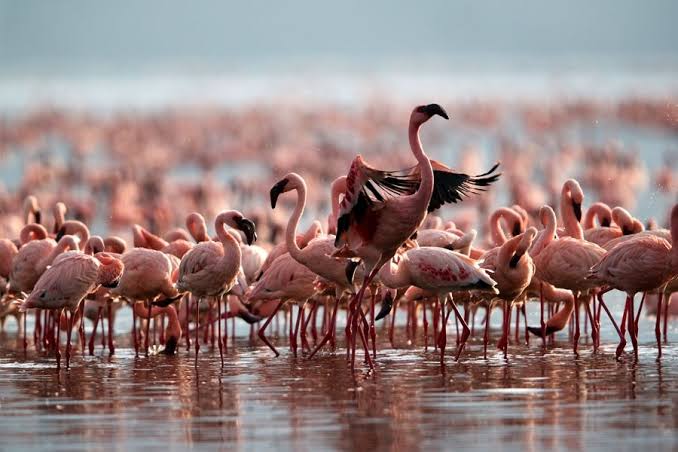
The flamingos feed on the blue-green algae that are always on this soda lake and hover around the lake shores, covering the lake pink, from afar, all you can see is the pink color of the flamingos coupled with the deep blue lake waters. The huge availability of food on the lake keeps the flamingos hooked on the lake’s shores, with the lake hosting up to 1.5 million flamingos in the flamingo peak seasons.
Though climate change has affected the number of flamingos on the lake, you can still be sure to find over a thousand flamingos on the lake shores on any given day. The number of flamingos on the lake is further affected by the alkaline levels on the lake. Thus when the alkaline levels on Lake Nakuru drop, the blue-green algae levels on the lake drop causing the birds to migrate to other soda lakes like Lake Bogoria in the such for food, vice versa is true when the alkaline levels on Lake Nakuru are high flamingos will crowd lake Nakuru.
Flamingos’ boom occurs immediately after the rainy season sometimes even during the rainy season; immediately after the rainy season, the blue-green algae on the lake is in abundance so the flamingo food is in plenty meaning flocks of flamingos will flock to the lake for the food.
The seasons before the rains have the least number of flamingos on the lake (least here means like a few thousand flamingos), before the rains the blue-green algae levels on the lake have significantly reduced causing the flamingos to migrate to other lakes to look for food.
The dry seasons have a good number of flamingos on the lake because the blue algae levels on the lake are okay not abundant and yet not low, so flamingos are getting enough food for their days.
Therefore the best time to see flamingos on Lake Nakuru in Lake Nakuru National Park is during July, August, September, December, January, and February. That said you can still see flamingos in plenty even in the rest of the months of the year. You should also note in the above-mentioned months there are more people in the park also catching a glimpse of the flamingos so your flamingo viewing may be a little interfered with by other people but you still get to see the flamingos.
Although the breath-taking lesser and greater flamingos are the main attraction of Lake Nakuru, the lake also hosts several other bird species like the African fish eagle, pelicans, shining sunbird, Rufous-throated wryneck, montane white eye, Montane Nightjar, Northern anteater chat, reed cormorant, blacksmith plover, and many others.
Lake Nakuru National Park which is home to Lake Nakuru, is also a wildlife zone with over 50 mammal species living in the park that include buffalos, baboons, monkeys, lions, leopards, waterbucks, Impalas, and others.
The park is also a Rhino Sanctuary, protecting over 100 rhino individuals (black and white) together with the Rothschild’s giraffe.